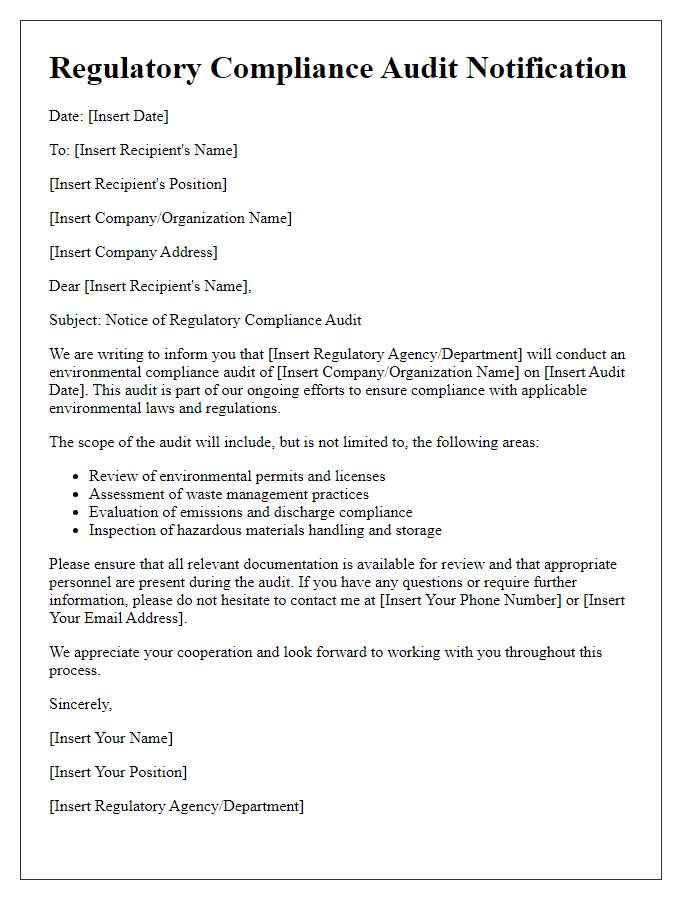Are you navigating the complex world of environmental law compliance? Understanding the regulations can be overwhelming, but it doesn't have to be. Our letter template provides a clear framework to help you communicate your commitment to sustainability and legal adherence effectively. Dive in to explore how this resource can simplify your compliance journey and enhance your environmental initiatives.

Legal Requirements
Environmental law compliance involves adhering to legislation designed to protect natural resources and public health. Key legal requirements include the Clean Air Act (1963), aimed at regulating air emissions from both stationary and mobile sources, and the Clean Water Act (1972), focused on maintaining water quality in rivers, lakes, and streams. Organizations must also consider the Resource Conservation and Recovery Act (1976), which governs hazardous waste management, ensuring proper disposal methods. Compliance audits conducted annually help identify any non-conformance with regulations, while environmental impact assessments (EIAs) are crucial for projects that may significantly affect the environment. Penalties for violations can include substantial fines, enforced remediation, and potential legal action, emphasizing the need for rigorous adherence to established environmental standards.
Environmental Impact Assessment
An Environmental Impact Assessment (EIA) is a crucial process mandated by regulations to evaluate potential environmental consequences of proposed projects, such as construction or mining activities, before they are undertaken. In many jurisdictions, including the European Union and the United States, EIAs are legally required for significant projects to ensure compliance with environmental laws and protection standards. This assessment typically involves rigorous analysis of various factors including air quality, water resources, biodiversity, and cultural heritage. The process often requires public consultation, gathering input from stakeholders, and considering alternatives to minimize adverse effects. Reports generated from EIAs play a vital role in decision-making, helping authorities determine whether a project can proceed, and under what conditions, to mitigate any potential damage to the environment, ecosystems, and surrounding communities.
Monitoring and Reporting
Environmental law compliance involves stringent monitoring and reporting processes to ensure adherence to regulations. Various industries, such as manufacturing and agriculture, must track emissions (quantifiable outputs of pollutants) and waste management practices to align with federal laws, such as the Clean Air Act and the Resource Conservation and Recovery Act. Regular assessments (including semi-annual or annual reports) are essential for identifying compliance gaps and addressing potential environmental impacts. The Environmental Protection Agency (EPA), which oversees regulatory enforcement, mandates detailed record-keeping of hazardous waste disposal methods and air quality measurements. Effective monitoring tools, such as emissions sensors and data management software, facilitate real-time tracking, while thorough reporting frameworks ensure transparency and accountability. Non-compliance can result in penalties, lawsuits, and damage to a company's reputation within communities and industries.
Risk Management Protocols
Environmental law compliance is crucial for organizations aiming to reduce their ecological impact while adhering to regulations. Risk management protocols are established frameworks that identify, assess, and mitigate potential environmental risks associated with business activities. These protocols often incorporate elements such as Environmental Impact Assessments (EIAs), which evaluate the potential effects of proposed projects, typically mandated by governmental bodies. Organizations may also conduct regular compliance audits to ensure alignment with local, state, and federal environmental laws, such as the Clean Water Act and the National Environmental Policy Act. Training programs aimed at staff education on sustainable practices enhance awareness and reduce risks. Furthermore, effective incident response plans and emergency preparedness measures are vital to address potential spills or leaks, ensuring swift action to minimize environmental damage.
Stakeholder Engagement
Stakeholder engagement is crucial for achieving effective environmental law compliance within projects. This process involves gathering input from various parties, including local communities, government agencies, and environmental organizations, ensuring all voices are heard. Engaging stakeholders at the early stages, during public consultations, can enhance trust and transparency. For instance, the Environmental Protection Agency (EPA) emphasizes meaningful participation, allowing stakeholders to influence decision-making. Additionally, documenting stakeholder feedback not only fulfills regulatory requirements but also helps identify potential environmental impacts associated with development activities. Strong engagement practices can lead to mutually beneficial outcomes, fostering enhanced regulatory compliance and sustainable resource management in projects across sectors like energy, agriculture, and urban development.













Comments